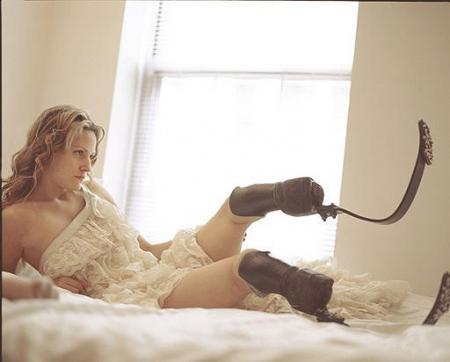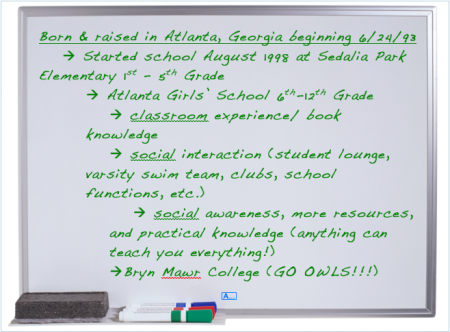Serendip is an independent site partnering with faculty at multiple colleges and universities around the world. Happy exploring!

My Access to Education Map
My friend Midley deserves credit (I borrowed her markers) so she's in the picture too!

Snapshots Through my Education
Honk. Honk.
Eyes open just as the sun comes up. The big sunshine yellow bus sits, waiting for me as I pull the velcro on my shoes snugly across the tops of my little feet, pink Barbie backpack hung neatly over my shoulders.
I blink and I am in the middle of Ms. Thomas' classroom, showing off my latest story to the class. This time its about the dinosaurs that tried eating my dog for breakfast.
I blink and I am walking down the corner, to all the third classrooms. As a measly second grader my knees start to shake, but then I remember my duty as the official mailwoman of Dutch Neck School, and I march on fearlessly.
I blink and I am finally in third grade, waiting to move onto bigger and better things. It is the last time I shake hands with Mr. Grabell on my way out to catch the bus...
I blink... and my two years in upper elementary blur together, not quite making sense, but only evoking the excitement of finally becoming a middle schooler.
I blink and I am in a sea of braces and glasses. While the pigtails have started to go away, I see Ugg boots and mini skirts take its place. But I was too busy with my math book under my nose to really pay attention to that.
I blink and my years as a middle schooler come to a close and I walk down the aisle of teachers, reaching their hands out to congratulate me and the 364 other students in my class.
Just as I blink, I am walking down the halls of High School North, so used to being at the top, that this idea of listening to the seniors makes no sense.

Making Disability "Palatable"
In reading through the notes for the “Cripping Sex and Gender” disability panel, I came across class notes from when Kristin taught the course that included images of Aimee Mullins (/exchange/courses/gas/f09/archive/15). I was struck by these images, and reminded of Wilchin’s discussion of the gender in relation to sexuality and the gay movement- how the gay rights movement has tried to “normalize” homosexuality by presenting with the idea that gays and lesbians are just like everyone else (i.e. the image of the monogamous, masculine (but not too masculine) gay couple with two dogs and a house with a white picket fence.) Wilchins argues that though these images have had success in bringing homosexuality into mainstream culture, they ultimately fail to challenge the underlying issue- gender. Creating this new, more “palatable” gay failed to challenge the underlying gender stereotypes that form the foundation of sexual-based discrimination.


Response to "Cripping Sex and Gender"

The Break Down of my Access Map
Home:
Born July 20, 1993. I grew up in a two parent household as an only child. My parents were very involved in my early education, reading to me and playing board games with me. My parents held positions on the PTA at my elementary and middle school. Between home and school there was an open dialect between my parents and teachers until high school.
School:
Complicated identities
Last week in class we discussed the article "Living the Good Lie" about homosexual men living outwardly as straight men, with wives and children. One of the driving forces behind their decisions to do this was that while they recognized their inward identity as being gay, their greater identity emphasis was on being religious. These men were willing to compromise their homosexual identity in favor of their (stronger) religious identity.



